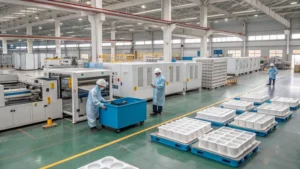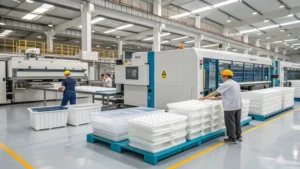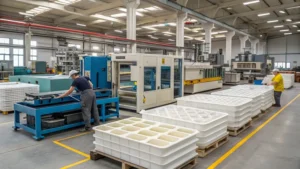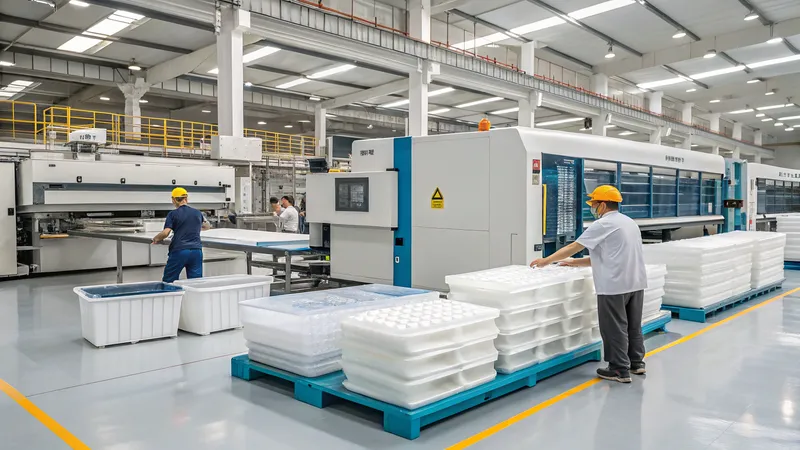
Vacuum forming is a versatile and cost-effective manufacturing process that heats a plastic sheet, stretches it over a mold, and uses a vacuum to shape it, creating lightweight, durable products. From packaging and automotive parts to medical devices and consumer goods, this technique is widely used for its affordability and adaptability. In Canada, several factories excel in vacuum forming, offering specialized services for both prototyping and large-scale production.
Canada is home to top-tier vacuum forming factories1 that provide high-quality, custom plastic manufacturing solutions2 for diverse industries.
This article explores the top 10 plastic vacuum forming factories in Canada, detailing their services, locations, and strengths. We’ll also dive into the formowanie próżniowe3 process, its materials, applications, and how it compares to other methods, helping you choose the right factory for your needs.
- 1. What Are the Top 10 Plastic Vacuum Forming Factories in Canada?
- 2. What Is Vacuum Forming and How Does It Work?
- 3. What Are the Common Materials Used in Vacuum Forming?
- 4. What Are the Steps in the Vacuum Forming Process?
- 5. What Are the Applications of Vacuum Forming?
- 6. How Does Vacuum Forming Compare to Other Methods?
- 7. What Factors Should You Consider When Choosing a Factory?
- 8. Wnioski
What Are the Top 10 Plastic Vacuum Forming Factories in Canada?
The following factories stand out for their reputation, expertise, and ability to deliver precision and innovation in vacuum forming.
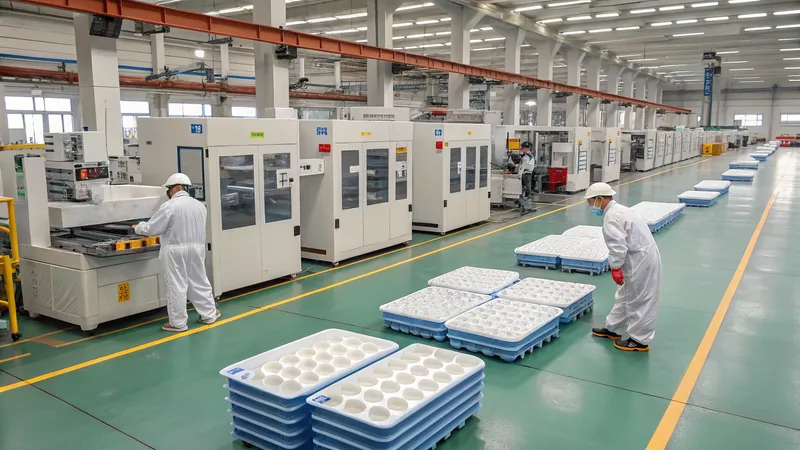
These 10 Canadian factories lead the vacuum forming industry, offering custom design4, prototypowanie5, and production services across sectors like automotive, medical, and packaging.
| Company Name | Location | Key Services | Industries Served |
|---|---|---|---|
| Formtech Plastics Inc. | Canada (likely Ontario) | Custom vacuum forming, design, consultation | Automotive, OEM, advertising, recreational |
| Waveform Plastics | Burks Falls and Toronto, ON | Product design, tooling, vacuum molding, CNC trimming | Medical, automotive, electronics, marine |
| Plastec | Vancouver, BC | Vacuum forming for food trays, race car parts, light fixtures | Food, automotive, retail, OEM |
| Drader Manufacturing | Edmonton, AB; Brampton, ON | Custom thermoforming, vacuum forming | Food services, plumbing, construction, agriculture |
| Plastics Source | Ontario | High-quality vacuum forming, prototyping | Various (nationwide shipping) |
| Formco Plastics | Canada | Vacuum forming and molding | General plastics manufacturing |
| Custom Prototypes | Toronto, ON | Vacuum forming for prototypes, short-run production | Drone, automotive, medical, consumer products |
| Saver Innovations | Toronto, Cambridge, ON | Heavy-gauge vacuum forming, custom design | Automotive, furniture, medical |
| Acrylic Depot | Toronto, ON | Custom and mass-produced thermoforming | Retail, medical, automotive, industrial |
| VTF Inc. | Spencerville, ON | Vacuum thermal forming, expert advice | Various (over 40 years of experience) |
These factories showcase Canada’s strength in plastic manufacturing, with companies like Waveform Plastics offering ISO9001:2015-certified quality and VTF Inc. bringing decades of experience.
Canada is a leading hub for vacuum forming innovation.Prawda
With specialized factories and a focus on quality, Canada excels in vacuum forming technology.
All listed factories offer identical services.Fałsz
Each factory has unique strengths, such as CNC trimming at Waveform Plastics or heavy-gauge forming at Saver Innovations.
What Is Vacuum Forming and How Does It Work?
Vacuum forming is a type of termoformowanie6 where a plastic sheet is heated until pliable, placed over a mold, and shaped using a vacuum. It’s ideal for creating large, shallow parts like trays and panels.
Vacuum forming heats a plastic sheet, stretches it over a mold, and applies a vacuum to shape it, producing cost-effective, lightweight parts for various industries.

The process starts with heating a arkusz termoplastyczny7 to its forming temperature (typically 120-180°C). The sheet is then positioned over a mold, and a vacuum pulls it tightly against the mold’s surface. After cooling, the part is trimmed and finished. This method excels at producing consistent, smooth parts with low tooling costs.
Vacuum forming is less precise than injection molding.Prawda
It offers cost advantages but lacks the detail and complexity of injection molding.
Vacuum forming is only for small-scale production.Fałsz
It’s effective for both small and medium-to-large runs due to affordable tooling.
What Are the Common Materials Used in Vacuum Forming?
Material choice is key to a vacuum-formed part’s properties, such as durability or transparency. Canadian factories use a range of thermoplastics tailored to specific needs.

ABS, PETG, polycarbonate, and HIPS are commonly used in vacuum forming for their durability, clarity, and ease of shaping in industries like automotive and packaging.
| Materiał | Właściwości | Zastosowania |
|---|---|---|
| ABS | Durable, impact-resistant, cost-effective | Automotive parts, housings |
| PETG | Clear, food-safe, flexible | Blister packs, medical trays |
| Poliwęglan | Wysoka udarność, odporność na ciepło | Safety shields, automotive parts |
| HIPS | Lightweight, affordable, high impact strength | Opakowania, oznakowanie |
For example, ABS is popular in automotive applications, while PETG suits food-safe packaging. Factories select materials based on project requirements like strength or chemical resistance.
Material selection impacts cost and quality.Prawda
Different materials vary in cost and performance, affecting the final product.
All thermoplastics work in vacuum forming.Fałsz
Only specific reformable thermoplastics like ABS are suitable.
What Are the Steps in the Vacuum Forming Process?
The vacuum forming process involves several precise steps to ensure quality output.
Wybór materiału8, heating8, forming, cooling, and trimming are key steps in vacuum forming, critical for high-quality plastic parts.
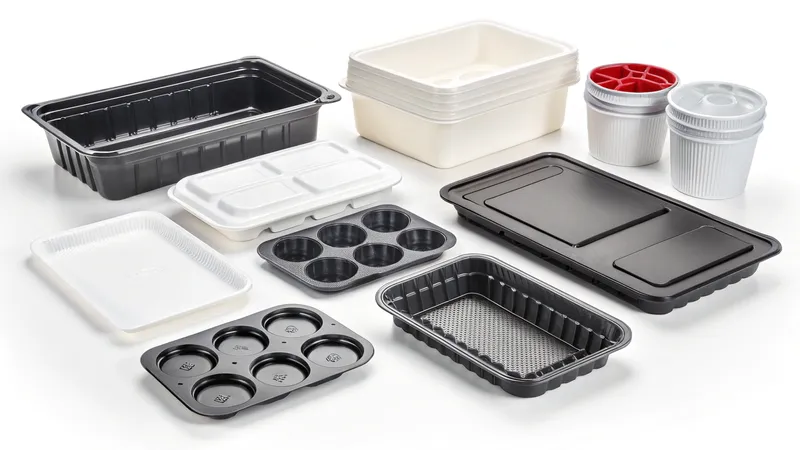
-
Wybór materiału: Picking the right thermoplastic for the job.
-
Ogrzewanie: Warming the sheet to its forming temperature.
-
Formowanie: Applying a vacuum to shape the sheet over a mold.
-
Chłodzenie: Setting the shape with fans or water mist.
-
Przycinanie i wykańczanie: Cutting excess material and adding final touches.
Factories like Formtech Plastics Inc. master these steps with advanced equipment to avoid issues like warping.
Vacuum forming molds are expensive.Fałsz
Molds can be made from affordable materials like wood, unlike injection molding.
The process is fully automated.Fałsz
Skilled operators often oversee it for quality control.
What Are the Applications of Vacuum Forming?
Vacuum forming’s versatility makes it a staple across industries.
It’s used in packaging, automotive, medical, and consumer goods for trays, covers, panels, and custom parts.

-
Opakowanie: Trays and blister packs for product protection.
-
Motoryzacja: Dashboards and door panels.
-
Medyczny: Sterile trays and housings.
-
Towary konsumpcyjne: Toys and appliance parts.
Vacuum forming is limited to simple shapes.Fałsz
Advanced techniques like plug-assist forming enable complex designs.
Vacuum-formed parts are less durable than injection-molded ones.Fałsz
Durability varies by material; polycarbonate parts can be highly durable.
How Does Vacuum Forming Compare to Other Methods?
Comparing vacuum forming to alternatives like injection molding highlights its unique benefits.

Vacuum forming offers niższe koszty oprzyrządowania9 oraz faster prototyping10 than injection molding, but it’s less precise and slower for high volumes.
| Aspekt | Formowanie próżniowe | Formowanie wtryskowe |
|---|---|---|
| Koszt oprzyrządowania | Niski | Wysoki |
| Prędkość produkcji | Umiarkowany | Wysoki |
| Złożoność części | Simple to moderate | Wysoki |
| Odpady materiałowe | Higher (trimming) | Niższy |
| Najlepsze dla | Prototypes, medium runs, large parts | High-volume, complex parts |
Vacuum forming suits quick, cost-effective projects, while injection molding excels in high-volume precision11.
Vacuum forming is always cheaper.Fałsz
Tooling is cheaper, but per-unit costs rise for large volumes.
What Factors Should You Consider When Choosing a Factory?
Picking the right factory ensures project success.
Experience, equipment, quality control, and customer service are key when selecting a vacuum forming factory.
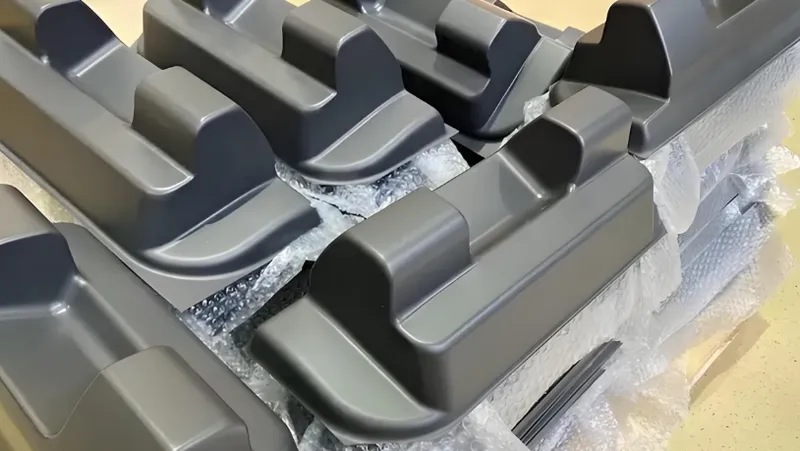
-
Experience: Proven expertise, like VTF Inc.’s 40 years.
-
Equipment: Modern tools, such as Waveform Plastics’ CNC machines.
-
Kontrola jakości: Certifications like ISO9001:2015.
-
Customer Service: Design and prototyping support.
Experience is the most critical factor.Prawda
Experienced factories deliver better results and handle complexity well.
Wnioski
Canada’s top vacuum forming factories, including Formtech Plastics Inc. and Waveform Plastics, offer exceptional solutions for custom plastic manufacturing. By understanding the process, materials, and selection criteria, businesses can tap into these capabilities for innovative, cost-effective products. As demand grows, these factories are poised to lead in vacuum forming technology.
-
Learn about the leading vacuum forming factories in Canada to find the best options for high-quality plastic manufacturing services. ↩
-
Discover the advantages of custom plastic manufacturing solutions and how they can meet specific industry needs effectively. ↩
-
Zapoznaj się z tym linkiem, aby zrozumieć proces formowania próżniowego i jego zastosowania w różnych branżach, poszerzając swoją wiedzę na temat technik produkcji. ↩
-
Discover how custom design plays a crucial role in optimizing vacuum forming processes and improving product quality. ↩
-
Learn about the advantages of prototyping in vacuum forming, including cost savings and design validation before mass production. ↩
-
Discover the various thermoforming processes, including vacuum forming, to gain insights into their unique benefits and applications in production. ↩
-
Learn about thermoplastic sheets and their significance in manufacturing processes, including vacuum forming, to better understand material choices. ↩
-
Understanding material selection is crucial for achieving optimal results in vacuum forming, ensuring quality and durability of the final product. ↩ ↩
-
Zrozumienie korzyści płynących z niższych kosztów oprzyrządowania może pomóc firmom zaoszczędzić pieniądze i poprawić wydajność produkcji. ↩
-
Exploring the impact of faster prototyping can reveal how it accelerates innovation and reduces time to market. ↩
-
Learning about high-volume precision can enhance your understanding of quality control and production efficiency in large-scale manufacturing. ↩



